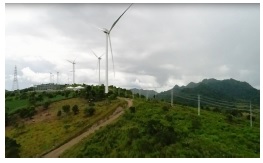Pengaruh PLTB Sidrap Terhadap Sistem Kelistrikan Sulawesi Selatan
Abstract
New and renewable energy has become the green energy trend in the electric power system going forward. The Bayu Power Station (PLTB) is one of the centers of electricity generation with a primary source of energy that is pollution-free and environmentally friendly. Currently in the South Sulawesi system, PLTB has operated with a total power of 70 MW at a base load of around 700 MW. Because PLTB is very dependent on wind conditions, the power generated becomes unstable and this has a significant intermittent effect on the stability of the system. The results of this study indicate that the intermittent composition of nuclear power plants is increasing from the April-July 2018 period. This ever increasing contribution disrupts frequency stability in the South Sulawesi system
Downloads
References
[2] Yunfeng Liu, Jian Zhang. 2018. “Research on The Effects of Wind Power Grid to The Distribution Network of Henan Province”. AIP Conference Proceeding 1955, 030005 (2018).
[3] Made Dwi Noviantara, I Nengah Suweden, I Made Mataram. 2018. “ Analisis Stabilitas Sistem Tenaga Listrik dengan Automatic Generation Control (AGC) Dua Area menggunakan Metode Fuzzy Logic Controller”. Majalah Ilmiah Teknologi Elektro, Vol 17, No. 2, Mei - Agustus 2018.
[4] A.Kusiak. 2009. “Prediction of Wind Farm Power Ramp Rates: A Data- Mining”. Journal of Solar Energy Engineering, University of Iowa.
[5] Cristobal Gallego-Castillo, Alvaro Cuerva-Tejero,Oscar Lopez-Garcia. 2014. “A review on the recent history of windpower ramp forecasting”. DAVE-ETSIAE, Universid ad Politecnicade Madrid.Pza Cardenal Cisneros,3, 28040 Madrid, Spain.
[6] Dede Subakti, Director, Operations Engineering Services. 2018. “Renewable Energy Market and Transactions Mechanism”. California ISO.
[7] Guodong Liu, KevinTomsovic. 2012. “Quantifying Spinning Reserve in Systems With Significant Wind Power Penetration”. IEEE Transactions On Power Systems, Vol. 27 No. 4 November 2012.
[8] Miguel Angel Ortega Vazquez. 20016. “Optimizing the Spinning Reserve Requerement”. University of Manchester for the degree of Doctor of Philosophy in the Faculty of Engineering and Physical Science
[9] Stephen Rose and Jay Apt. 2015. “The Cost of Curtailing Wind Turbines for Frequency Regulation and Ramp-Rate Limitation”. Carnegie Mellon Electricity Industry Center Department of Engineering and Public Policyand Tepper School of Business Carnegie Mellon University.
[10] Yih-huei Wan. 2011. “Analysis of Wind Power Ramping Behavior in ERCOT”. Technical Report NREL/TP-5500-49218, National Renewable Energy. Laboratory 1617 Cole Boulevard Golden, Colorado 80401
[11] Haijiao Wang, Zhe Chen, Quanyuan Jiang. 2015. “ Optimal Control Method for Wind Farm to Support Temporary Primary Frequency Control with Minimised Wind Energy Cost”. IET Renewable Power Generation, 2015, Vol. 9 Iss. 4, pp. 350-359.
[12] S. Janarthanan. 2017. “ Analysis of Grid Connected DFIG based Wind Farms for Reactive Power Compensation”. International Journal of Latest Technology in Engineering, Management & Applied Science (IJLTEMAS), Volume VI, Issue VI, June 2017.
[13] Ahmed F. Zobaa, Ibrahim Ahmed, Shady H.E., Abdel Aleem. 2019. “ A Comprehensive Review of Power Quality Issues and Measurement for Grid-integrated Wind Turbines”. Recent Advances in Electrical & Electronic Engineering, 2019, 12, 210-222.
[14] D. Zappala, N. Sarma, S. Djurovic, C.J. Crabtree, A. Mohammad, P.J. Tavner. 2019. “ Electrical & Mechanical Diagnostic Indicators of Wind Turbine Induction Generator Rotor Faults”. Elsevier Ltd. Renewable Energy 131 (2019) 14-24.


This work is licensed under a Creative Commons Attribution-NonCommercial-NoDerivatives 4.0 International License.

This work is licensed under a Creative Commons Attribution 4.0 International License




